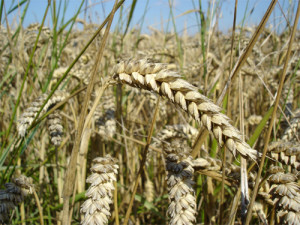
Ya know, every so often I catch Dr. Oz and his show. This past week his guest, Dr. Davis, author of the Wheat Belly was talking about Franken Wheat….. what wheat looks like today, as compared to the past, now stripped of most of its’ value. I always thought it whole wheat was the ‘thing’ to do. Better than white. Lots of fiber.
And I think the real problem in today’s world is that we have so much access and have a clearer vision, pictures and all, of what ‘they’ have done to our food. So much so that Dr. Davis says wheat is now high on the glycemic index, worse than sugar for you! The show went on to talk about how wheat stimulates the appetite, causes inflammation, makes wholes in your intenstinal track, making it possible for bigger, badder things to get in there, so now you’re not just getting nutrients…
YIKES CHEF MARIAN! THAT’S CRAZY BAD!
Yep. That’s why I am talking about it.
And it doesn’t stop there. They’re talking about wheat creating auto immune disease, acid reflux, irritable bowel syndrome, joint paint, itching skin….
And what they are asking for is 5 days. 5 days of wheat free they say gives you more energy, and stops those fingers from hurting. Yes. I actually had my fingers cramp up on me this past month, something I’ve never experienced before. So, I think that’s a fair trade. No wheat for 5 days. I’m ‘on it’. Starting today.
Raw nuts, veggies, protein, fruits, some occasional brown rice, lentils and black beans with a clear avoidance of gluten free food in general, because the good doctor says tapioca, rice flour, corn starch and potato flour is what they use to substitute out…. and all of those things are high glycemic. Plus they’re known to list low in fat and trade the difference out by adding sugar for flavor. We still have to read those labels…. probably now more than ever. And did you know that when a label says “No Trans Fats”, it’s not true? It’s just that it’s under .5%, so the FDA let’s them round down. But if you eat a bunch of the product. Guess what? You’re getting trans fats. So READ the label!
Dr. Davis is suggesting tofu Shirataki Noodles in place of pasta and flaxseed wraps, which I actually think I’ve seen at the store.
Which brings me to noodles. I mean, what is wheat and what isn’t?
Wiki has this to say:
Ramen are thin, wheat-based noodles made from wheat flour, salt, water, and kansui, a form of alkaline water. The dough is risen before being rolled. They were imported from China during the Meiji Period. Ramen noodles have a firm texture and are usually pale yellow in color. The noodles may vary in shape, width, and length. They are served in a broth. Examples of ramen dishes are misoramen, shio ramen, tonkotsu ramen, and shoyu ramen.
Shirataki are clear noodles made from konnyaku. These noodles are chewy or rubbery. Shirataki are used to add texture to dishes such as sukiyaki and oden.
Soba is a noodle made from buckwheat and wheat flour. Soba noodles are available dried or fresh. They may be served with hot broth or cold with dipping sauce. Examples of soba dishes are zaru soba (chilled), kake soba, tempura soba, kitsune soba, andtororo soba. Although the popular Japanese dish Yakisoba includes “soba” in its name, the dish is made with Chinese style noodles (chūkamen).[2]
Sōmen noodles are a very thin, white, wheat-based noodle. They are usually served chilled in the summertime with dipping sauces although they may be used in soups and other hot dishes. Sōmen noodles are very similar to hiyamugi and udon noodles, only they are thinner (about 1.3mm in width). Sōmen requires oil in its manufacture. During the summer months Japanese consume chilledsōmen to stay cool.[1]
Hiyamugi are wheat flour noodles similar to sōmen and udon noodles and somewhere in between the two in size. These noodles are often served in the same manner as sōmen and udon noodles. While they are mostly white, there are bundles mixed with noodles of pinkish or brown hues.
Udon are the thickest of the noodles served in Japanese Cuisine. Udon are white, wheat-based noodles, that are 4-6mm in width. These noodles are served chilled with a dipping sauce in the summer months, or in hot dishes and soups when the temperature is cooler. Udon dishes include kitsune udon, Nabeyaki udon, curry udon, bukkake udon, and yaki udon. However, sara udon is made using a different kind of noodle which is crispy.
So reviewing all this we clearly see there is white wheat noodle, wheat based noodle and only one that is not wheat based, and that’s the Shirataki. Guess it’s worth checking out. Doubt it will satisfy my pasta craving… but hey! We’re only talking 5 days right? Let’s see if it makes a difference!
And if you’re bored with your smoothies like me? Dr Oz is suggesting kale, cucumber, celery, strawberry and water. I’d probably throw some banana in too.
Would you like to join me for a wheat free week?
Happy Eating,
Chef Marian